
Another Deck Clinic, another approach. What to do when you come home from the Sneak Preview? You have a bunch of shiny new cards and you’re still excited about the new mechanics and teams, but you don’t yet have the grasp on things that you have with previous sets. The first thing many people do (myself included) is go through the cards they’ve already managed to pick up, lay out character curves for the various teams, and try to see the character skeleton of a deck or pick out resources and characters that interact in particularly interesting ways. Often, you’re faced with choices that you’re not really in a position to make an informed decision on, such as choosing which of two core mechanics to make the most use of in a multi-team deck. Hopefully, this week’s article should provide a useful way of approaching such a decision.
The Submission
This is what Vsrealms.com poster NiGHTxW1NG asked for ideas about; if it looks rougher than other “starting point” decklists, there’s a good reason—this is what real first drafts often look like for new sets when you don’t have cards and may not even have seen a full spoiler list. Consequently, it has cards that you wouldn’t consider playing after a few more weeks, and is missing things that you simply didn’t see at the Sneak Preview. If you don’t at least experiment with the less obvious cards, you may miss something important, and playing around with the cards you picked up at a Sneak Preview is a good way to get familiar with the themes of new sets and teams. The magic happens after you get home, sit down with a spoiler list, and start to brainstorm ideal lists, rather than just working with what you managed to pick up on Sneak Preview day.
Here’s what NiGHTxW1NG said about his list:
“I made this deck from most of the stuff I got at the Sneak Preview, so I guess that makes it Modern Age. Thanks in advance for the help. I’d prefer to use only cards from this set because this is mainly a fun deck for me.”
Characters
4 Galan, Famished
2 Morg, Slayer
4 Dr. Doom, Richards’s Rival
2 Iron Man, Illuminati
1 Crystal, Elementelle
2 Human Torch, The Invisible Man
2 Morg, Corrupt Destroyer
2 Silver Surfer, Righteous Protector
2 Dr. Doom, Sorcerous Savant
1 Firelord, Harbinger of Havoc
2 Galactus, The Maker
1 Adam Warlock, Protector of the Soul Gem
Plot Twist
4 Creation of a Herald
4 The Herald Ordeal
1 For the Glory of Doom!
3 The Uni-Power
4 Inspiring Demise
4 Relentless Onslaught
1 Mask of Doom
4 The Devil We Know
Locations
4 Soul World
1 Arsenal of Doom
Equipment
1 Time Gem, Infinity Gem
1 Reality Gem, Infinity Gem
1 Mind Gem, Infinity Gem
1 Power Gem, Infinity Gem
1 Soul Gem, Infinity Gem
Initial Thoughts
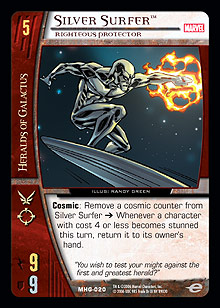 First of all, let’s break down the basics. The primary team is Heralds of Galactus, with a splash of Doom and a couple of other characters (Crystal, Elementelle representing the Inhumans and Adam Warlock, Protector of the Soul Gem waving the flag for the Infinity Watch). The deck generally seems quite aggressive, with a sub-theme of bouncing and KO’ing opposing characters through Silver Surfer, Righteous Protector; both versions of Morg; Adam Warlock; The Devil We Know; and Soul Gem. This seems like a theme that could reward some investigation. If we can consistently remove opposing characters from the board without interfering with our aggressive game plan, then we’re left in a good position for lethal direct attacks on the turns that we control the initiative. With that in mind, we want to think about the options for keeping our opponent’s characters down.
First of all, let’s break down the basics. The primary team is Heralds of Galactus, with a splash of Doom and a couple of other characters (Crystal, Elementelle representing the Inhumans and Adam Warlock, Protector of the Soul Gem waving the flag for the Infinity Watch). The deck generally seems quite aggressive, with a sub-theme of bouncing and KO’ing opposing characters through Silver Surfer, Righteous Protector; both versions of Morg; Adam Warlock; The Devil We Know; and Soul Gem. This seems like a theme that could reward some investigation. If we can consistently remove opposing characters from the board without interfering with our aggressive game plan, then we’re left in a good position for lethal direct attacks on the turns that we control the initiative. With that in mind, we want to think about the options for keeping our opponent’s characters down.
As you might expect, the cheaper and more efficient methods for removing enemy characters have restrictions, generally on the cost of the character being removed. Soul Gem only triggers when the equipped character stuns a character of lower cost, and Silver Surfer, Righteous Protector can only cause characters of cost 4 or less to be returned to hand. Worldship returns characters of cost 3 or less. Morg, Corrupt Destroyer is a noticeable exception, but he is restricted by cosmic—surge. On the Doom team, Divinity, Vampiric General has a particularly brutal power, KO’ing any character he stuns . . . but at the cost of KO’ing a Doom character or resource in the build phase during each turn he remains in play. It’s the 4-drops, with their ability to bounce or KO characters straight across or even up the curve, that seem worthy of being the center of attention.
The two different 4-drops are already pulling in quite different directions. Morg is pulling toward a cosmic-enabling deck with cards like The Power Cosmic Unleashed or Pacification. Divinity pulls toward a deck with alternate recruit cost characters like Frankie Raye ◊ Nova, Optimistic Youth or Elite Doom Guards, Army; or toward ways of putting characters directly into play, like Armies of Doom. If we’re going to go with Morg, we need to investigate the options for renewing his cosmic counter on turn 4. A search for ”cosmic counter” in the set brings up the following options for adding counters:
- Pacification. Pacification is interesting, but with access only to cards from the Heralds of Galactus set, we may have limited capacity to ensure its usability by keeping our hand size higher than our opponent’s.
- Terragenesis. Like Pacification, this is ongoing, so it has potential. And it doesn’t have a difficult to achieve condition—just a discard cost. But it still can’t provide a counter to a character on the turn we recruit it, so it will likely be a secondary choice at best.
- Extended Family. Extended Family is efficient and provides a great second effect of teaming-up our characters. Notably, we can search out Extended Family on turn 3 simply by recruiting Crystal, Elementelle, giving us both our Inhumans character and our Team-Up.
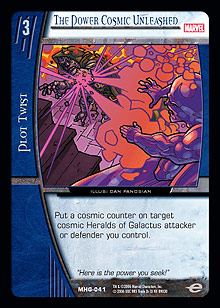 Looking at these options, the most attractive are The Power Cosmic Unleashed and Extended Family. This pushes us away from Doom and toward the Inhumans as our second team, as the Doom team is pretty much devoid of cosmic characters who would benefit from the counters, and we need Inhumans to allow Extended Family to put counters on our Heralds of Galactus characters. Meanwhile, even the briefest glance at the Inhumans roster turns up cosmic—surge hits like Jolen, The Treacherous One; Nahrees, The Negative One; and the standout aggressor of the team, Karnak, The Shatterer. The first time I ever recruited Galactus, The Maker in a test game with decks with Heralds cards, my opponent immediately proceeded to beat him up with a 1 ATK / 2 DEF 1-drop. Thanks, Karnak. Thanks a bunch.
Looking at these options, the most attractive are The Power Cosmic Unleashed and Extended Family. This pushes us away from Doom and toward the Inhumans as our second team, as the Doom team is pretty much devoid of cosmic characters who would benefit from the counters, and we need Inhumans to allow Extended Family to put counters on our Heralds of Galactus characters. Meanwhile, even the briefest glance at the Inhumans roster turns up cosmic—surge hits like Jolen, The Treacherous One; Nahrees, The Negative One; and the standout aggressor of the team, Karnak, The Shatterer. The first time I ever recruited Galactus, The Maker in a test game with decks with Heralds cards, my opponent immediately proceeded to beat him up with a 1 ATK / 2 DEF 1-drop. Thanks, Karnak. Thanks a bunch.
So, we have the beginnings of a curve: Crystal, Elementelle fetches Extended Family; and Morg, Corrupt Destroyer gives us both our teams, our Team-Up, and enables our cosmic—surge 4-drop. Karnak, The Shatterer on turn 5 gives Morg the chance to take down anyone from a 4- or 5-drop all the way up to Galactus himself.
Character Selection
Given that we’re working from the premise of a very early look at the set, we want to go through the available characters in more detail than usual. If there’s one piece of advice you take away from this article, it should be this: When the spoiler list for a new set is completed after a Sneak Preview, take it a team at a time and read every card. At least twice. While all of us will still miss things, particularly interactions between multiple cards, the quicker you become used to reading and working with the cards in a new set, the quicker you can do some serious deckbuilding and brainstorming. While some characters may be dismissed quickly, anything that looks at all interesting should be mentally filed away. It may be that a few “packages” of characters work well together (a certain 3-drop works well with a certain 2-drop and 5-drop, for example), and we could end up with a few different curves focusing on particular strong points of our teams.
1-drops
Let’s start off by making the first pass through for cards that simply aren’t appropriate or necessary for our theme. The Punishers, Army are the first to go, as we won’t be going for a swarm strategy that would benefit from their version and they’re otherwise devoid of useful text. Alpha Primitives, Army are a little different, since they act as a walking plot twist, effectively giving a card in your hand terraform. Not hugely exciting, but worth remembering if we end up running a number of the Inhumans cards that require a face-up resource row. Galan, Famished is a decent stall card, but that’s not really the direction we’re taking; we’re all about aggression, and a 1 ATK character with an endurance-gaining power isn’t what we’re looking for. Ahura, Heir to Attilan is an intriguing card, but we already know that our primary 3-drop is unlikely to be cosmic, which raises questions about how often her power will be usable. Her 1 ATK doesn’t help, so for now she’s a no-go. If the curve ends up being cosmic or cosmic—surge all the way up, with Crystal only as a backup, we may reconsider. Luna Maximoff, Only Human, is simply too fiddly. While recovery effects are useful, a recovery effect that can only recover a cheap character, has to be drawn naturally in our opening hand, costs a resource point, and returns to our hand when used is simply too restrictive for a full-curve deck. In a swarm deck with Dr. Light, Master of Holograms, Luna could come into her own, allowing you both to recover and hide the good Doctor.
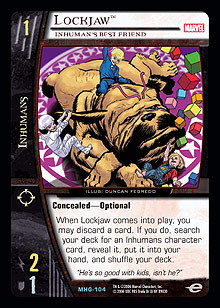 This leaves us with two options. The first is Lockjaw, Inhuman’s Best Friend. He’s the Boliver Trask of the team, and in my opinion easily deserves a slot. His 2 ATK, concealed—optional, and ability to smooth our curve makes him a great option. Frankie Raye ◊ Nova, Optimistic Youth provides card cycling rather than searching, which is a less attractive power, but with the option of an alternate recruit cost later in the game, she essentially lets us trade three unneeded cards for two new ones whenever she’s drawn. We may not end up with space or enough 4+ cost cards to make her truly efficient, but she bears consideration. One last point: with Karnak, The Shatterer in the deck, being able to recruit a free character to take out a 0 DEF higher drop is quite useful.
This leaves us with two options. The first is Lockjaw, Inhuman’s Best Friend. He’s the Boliver Trask of the team, and in my opinion easily deserves a slot. His 2 ATK, concealed—optional, and ability to smooth our curve makes him a great option. Frankie Raye ◊ Nova, Optimistic Youth provides card cycling rather than searching, which is a less attractive power, but with the option of an alternate recruit cost later in the game, she essentially lets us trade three unneeded cards for two new ones whenever she’s drawn. We may not end up with space or enough 4+ cost cards to make her truly efficient, but she bears consideration. One last point: with Karnak, The Shatterer in the deck, being able to recruit a free character to take out a 0 DEF higher drop is quite useful.
2-drops
The interesting 2-drops available to the Heralds and Inhumans are a little more numerous. Quickly running through the less attractive ones, Morg, Slayer is sadly not likely to join the team despite his interesting payment power because the 4-drop is our character of choice at that cost. Destroyer, Soulless Juggernaut is unexciting rather than strictly bad. If he had 5 ATK rather than 4, I might be prepared to overlook his tiny size after he loses his cosmic counter because he’d be able to stun a greater proportion of 3-drops, but 4 ATK / 4 DEF is just a little too small to justify the lack of abilities and cosmic. Franklin Richards, Creator of Counter-Earth has a very interesting triggered power, and one that I’m sure will see a lot of play in more controlling decks that need to manage the characters they leave visible on their opponent’s initiative more carefully. For now, though, I’m looking for something more aggressive. The same consideration deters me from going for San, The Alienated One. A 2 ATK 2-drop in the hidden area isn’t hugely exciting, and he doesn’t actually provide card advantage, just fixes your draws. Right now, we don’t even have key locations that we’ll need, so he can stay on the bench unless it becomes obvious later on that we’ll need to come back for him.
This leaves us with three options for 2-drops. Each of them has the magic number of 3 ATK—Silver Surfer, Skyrider of the Spaceways; Quicksilver, Inhuman by Marriage; and Black Bolt, Illuminati. Surfer provides an interesting new take on card search, allowing you to stack your deck with your higher cost cards. The only question then becomes, “Do I have enough expensive cards in the deck to make him worthwhile?” If all he’s doing is smoothing character draws a little, he’s less exciting. If he’s also fixing our resource draws, he gets a lot more attractive. Black Bolt provides the other side of the equation, allowing us to cycle the top card of our deck straight into our resource row. Quicksilver is nothing but aggression and good stats. For now, I’ll earmark the two as card-advantage generating drops, as their abilities seem more likely to be useful in most games than Quicksilver’s. If this was Golden or Silver Age and we could dump the Fate Artifacts on Quicksilver on turn 2 and swing for 14, we’d be slamming him straight into the pile.
3-drops
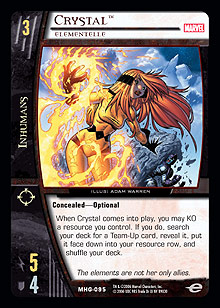 We already know that our primary 3-drop will be Crystal, Elementelle, who provides everything we could possibly ask for in terms of efficiency, with her 5 ATK, concealed—optional, and ability to search for our Team-Up and cosmic—surge enabler. There are a few other decent aggressive options; Firelord, Pyreus Krill; Tonaja, The Responsible One; Plasma, Replacement Herald; and Human Torch, Sparky are all perfectly acceptable characters with nothing hugely exciting to recommend them to us. None of them are as interesting to us as Crystal, but we may end up running a couple of copies of one as a backup. Jolen, The Treacherous One seems a better fit for a more controlling build, as do Air-Walker, Gabriel Lan and Frankie Raye ◊ Nova, Soul Searcher. Given that we will want a Heralds character at 3 to Kindred Spirits for if necessary, Firelord and Plasma seem like they’ll have the most potential, depending on our proportion of 4+ cost cards.
We already know that our primary 3-drop will be Crystal, Elementelle, who provides everything we could possibly ask for in terms of efficiency, with her 5 ATK, concealed—optional, and ability to search for our Team-Up and cosmic—surge enabler. There are a few other decent aggressive options; Firelord, Pyreus Krill; Tonaja, The Responsible One; Plasma, Replacement Herald; and Human Torch, Sparky are all perfectly acceptable characters with nothing hugely exciting to recommend them to us. None of them are as interesting to us as Crystal, but we may end up running a couple of copies of one as a backup. Jolen, The Treacherous One seems a better fit for a more controlling build, as do Air-Walker, Gabriel Lan and Frankie Raye ◊ Nova, Soul Searcher. Given that we will want a Heralds character at 3 to Kindred Spirits for if necessary, Firelord and Plasma seem like they’ll have the most potential, depending on our proportion of 4+ cost cards.
4-drops
 As with our 3-drop, we already know that our primary 4-drop is Morg, Corrupt Destroyer. His bounce power, unrestricted as it is by the cost of opposing characters, is the focal point for our mid-game plans. All we need to think about is whether we want to run a backup 4-drop, so let’s go through the options. The Heralds offer up Human Torch, The Invisible Man; Stardust, Merciless Warrior; and Terrax, The Tamer. From the Inhumans, there is Nahrees, The Negative One; Dewoz, Dark Reflection; Thing, Rockhead; and Triton, Aquatic Ambassador. The first cuts will be the characters that don’t support our aggressive plan, and particularly those that won’t play so well with Karnak, The Shatterer on turn 5. Dewoz and Terrax are the first to go, with unexceptional stats and defensive powers. Triton also has uninspiring stats and a power we’ll have trouble abusing (by keeping him unstunned through recovery each turn). Stardust is probably the best other option for the Heralds alongside Thing for the Inhumans, because we don’t particularly want to replace our breakthrough with endurance gain, and we should reliably be able to give Thing his cosmic counter. Nahrees is also interesting for her 8 ATK and ability to lock down opposing exhausted characters.
As with our 3-drop, we already know that our primary 4-drop is Morg, Corrupt Destroyer. His bounce power, unrestricted as it is by the cost of opposing characters, is the focal point for our mid-game plans. All we need to think about is whether we want to run a backup 4-drop, so let’s go through the options. The Heralds offer up Human Torch, The Invisible Man; Stardust, Merciless Warrior; and Terrax, The Tamer. From the Inhumans, there is Nahrees, The Negative One; Dewoz, Dark Reflection; Thing, Rockhead; and Triton, Aquatic Ambassador. The first cuts will be the characters that don’t support our aggressive plan, and particularly those that won’t play so well with Karnak, The Shatterer on turn 5. Dewoz and Terrax are the first to go, with unexceptional stats and defensive powers. Triton also has uninspiring stats and a power we’ll have trouble abusing (by keeping him unstunned through recovery each turn). Stardust is probably the best other option for the Heralds alongside Thing for the Inhumans, because we don’t particularly want to replace our breakthrough with endurance gain, and we should reliably be able to give Thing his cosmic counter. Nahrees is also interesting for her 8 ATK and ability to lock down opposing exhausted characters.
5-drops
Well, I’ve mentioned him often enough that you all know he’s coming: Karnak, The Shatterer. A card that will in all probability be the linchpin of every aggressive Inhumans deck and one of the most brutally aggressive payment powers in the game. At the moment, I see no real need to run a second 5-drop, as Karnak on turn 5 after Morg on turn 4 should be effective on either initiative. If our opponent controls the initiative on turn 5, we can recruit Karnak in the hidden area and leave our opponent only able to attack Morg with his or her 5-drop. If the opponent doesn’t have a way to pump over Morg’s 9 ATK, he or she will end up in a world of trouble.
6-drops
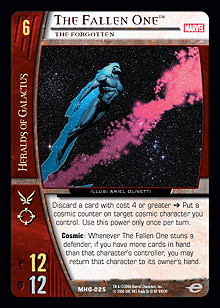 Moving on to 6, we have a choice to make. One 6-drop interacts well with our specific 4- and 5-drops of choice, while two of the others simply have strong aggressive powers in general. The Fallen One, The Forgotten is the Heralds of Galactus standout that allows us to put counters back on Karnak and Morg. My initial impression is that we won’t often be able to make use of his second power, but the fact that it’s there can only be a plus. The more straightforward aggressive options both seem good for attempting to go in for the kill with the initiative on turn 6. Firelord, Harbinger of Havoc can turn a character discard into a massive ATK pump, while Dinu, Face of Terror and Maximus the Mad, Mental Manipulator are all about disrupting your opponent’s ability to soak up damage when you attack, whether by hiding a character completely or by preventing reinforcement.
Moving on to 6, we have a choice to make. One 6-drop interacts well with our specific 4- and 5-drops of choice, while two of the others simply have strong aggressive powers in general. The Fallen One, The Forgotten is the Heralds of Galactus standout that allows us to put counters back on Karnak and Morg. My initial impression is that we won’t often be able to make use of his second power, but the fact that it’s there can only be a plus. The more straightforward aggressive options both seem good for attempting to go in for the kill with the initiative on turn 6. Firelord, Harbinger of Havoc can turn a character discard into a massive ATK pump, while Dinu, Face of Terror and Maximus the Mad, Mental Manipulator are all about disrupting your opponent’s ability to soak up damage when you attack, whether by hiding a character completely or by preventing reinforcement.
As we will certainly be running some character search effects, I’m happy to have a couple of different 6-drops for different situations. The Fallen One will definitely be one of them because in curve matchups, his first power will often translate into “Discard a card with cost 4 or greater >>> Target 6-drop gets -12 DEF while defending this turn.” If we’re looking for a secondary 6-drop, Firelord is the next best Herald, and superior if we don’t need The Fallen One’s cosmic ability. From the Inhumans, Maximus the Mad is capable of pushing excessive amounts of damage through when we control the initiative. The only question is whether we can satisfy the face-up resource row condition.
7-drops
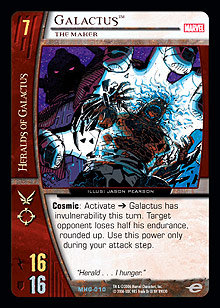 Here we come to a decision point. The obvious option is, well, who else? Galactus, The Maker. He turns Creation of a Herald from a decent search card into an outstanding one while still being a solid recruit. High drops that are useful for more than being recruited are always valuable, and Galactus is no exception. However, Creation of a Herald really needs significant numbers of copies of Galactus to come into its own, and we may not be comfortable devoting so much space. This wouldn’t be an issue if it weren’t for the fact that the Inhumans have two search cards (The Great Refuge and Lockjaw, Inhuman’s Best Friend) and the Heralds have one on top of Creation of a Herald (Kindred Spirits), thus providing us with enough options to choose between the face-up resource plan (running The Great Refuge) and the Creation engine.
Here we come to a decision point. The obvious option is, well, who else? Galactus, The Maker. He turns Creation of a Herald from a decent search card into an outstanding one while still being a solid recruit. High drops that are useful for more than being recruited are always valuable, and Galactus is no exception. However, Creation of a Herald really needs significant numbers of copies of Galactus to come into its own, and we may not be comfortable devoting so much space. This wouldn’t be an issue if it weren’t for the fact that the Inhumans have two search cards (The Great Refuge and Lockjaw, Inhuman’s Best Friend) and the Heralds have one on top of Creation of a Herald (Kindred Spirits), thus providing us with enough options to choose between the face-up resource plan (running The Great Refuge) and the Creation engine.
With Creation, we’ll be running four copies of Galactus. Without Creation, we’ll still have one copy as an on-initiative 7-drop, and we’ll be looking for something to recruit when we don’t control the initiative. Silver Surfer, Harbinger of Oblivion doesn’t seem to fit well, as we’re unlikely to want to skip the combat phase. Gorgon, Thundering Hooves is more of a stall card. Invisible Woman, Flame On! at first seems shaky due to her extremely low DEF. However, our plan with this deck is to remove our opponent’s 6-drop on turn 6 by attacking in with Morg, Corrupt Destroyer, at which point our opponent may not have anything to attack up the curve with. At this point, her burn power and solid ATK value balance out that 11 DEF. Dealing 6 or 7 direct endurance loss—even if she’s unable to stun back—could be quite significant, especially when followed by an attack back with our concealed characters. The other possibility is Adam Warlock, Protector of the Soul Gem. The problem with Adam is that he can only be fetched with Creation of a Herald, and the version of the deck running Creation is already overloaded with 7-drops. Unless the face-up resource version of the deck ends up running a card like Attilan, he won’t be playable in either build.
8-drops
Both of the available on-team 8-drops (Tyrant, The Original Herald and Black Bolt, Devastating Decree) are 19 ATK / 19 DEF, and both have interesting KO-related abilities. However, Tyrant’s power is asymmetrical, trading a cosmic counter for an opposing character; this is a power that seems more attractive than Black Bolt’s symmetrical board wipe.
9-drops
If we’re running Creation, it would be rude not to include a single copy of Galactus, Devourer of Worlds. If we’re not, he shouldn’t be necessary
Join me again tomorrow, when I’ll talk some more about the implications of the choice between Creation of a Herald and The Great Refuge and put together both the core character curve for the deck and the “packages” that fit best with each search card.